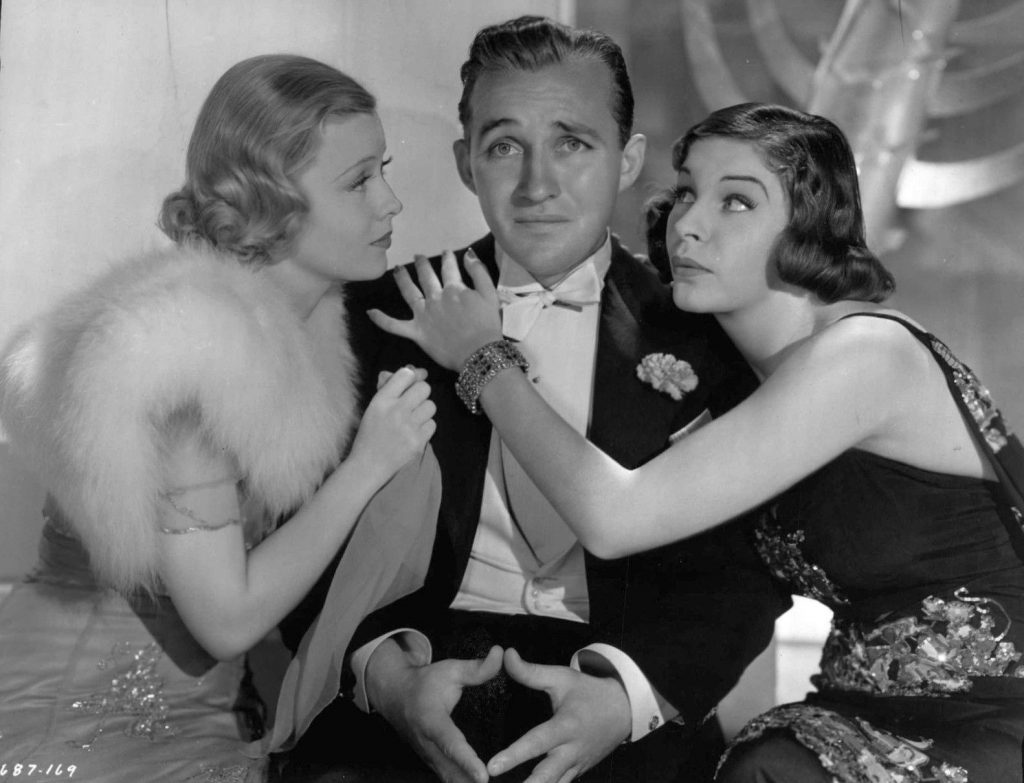Happy Birthday, Bing Crosby!
At one time in the 1940s, the man born Harry Lillis “Bing” Crosby, Jr. in Tacoma, Washington on this date in 1903 was the top-selling recording star…the number-one box office attraction…and the most popular performer on radio (headliner of The Kraft Music Hall). Author Gerald Nachman observed in his book on Radio’s Golden Age, Raised on Radio: “Pop singing can be divided roughly into ‘AC’ and ‘BC.’ Before Crosby, singers sang at you; after Crosby and radio, they sang to you.” The Yuletide standard White Christmas remains the best-selling single of all time (a tune Crosby introduced in the movie classic Holiday Inn), and after dedicating years to moviemaking, Bing received a Best Actor Oscar for his performance as a happy-go-lucky priest in the Academy Award winner for Best Picture that year, Going My Way (1944).
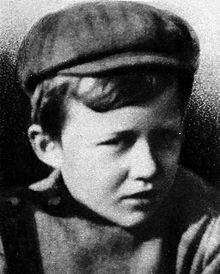 Acres of old growth forests have been cut down to produce paper for the number of books written about “The Old Groaner”—so it seems only fitting that I concentrate mostly on Bing’s accomplishments in the aural medium, what with this being Radio Spirits and all. It begins, of course, with Crosby’s childhood interest in music—purportedly it was a summer job as a prop boy at Spokane’s “Auditorium” that stoked his yearning for a musical career; he once watched a performance of Al Jolson and later described the experience as “electric.” Young Harry attended and graduated from Gonzaga Prep in 1920 and moved on to enrollment at Gonzaga University, where he attended the halls of ivy for three years. Crosby never graduated from Gonzaga (however, his brother Bob did), but he remains that school’s most famous alumnus; he received an honorary doctorate in 1937, and the house in which Bing was born now sits on the school campus (where, fittingly enough, it once housed the Alumni Association).
Acres of old growth forests have been cut down to produce paper for the number of books written about “The Old Groaner”—so it seems only fitting that I concentrate mostly on Bing’s accomplishments in the aural medium, what with this being Radio Spirits and all. It begins, of course, with Crosby’s childhood interest in music—purportedly it was a summer job as a prop boy at Spokane’s “Auditorium” that stoked his yearning for a musical career; he once watched a performance of Al Jolson and later described the experience as “electric.” Young Harry attended and graduated from Gonzaga Prep in 1920 and moved on to enrollment at Gonzaga University, where he attended the halls of ivy for three years. Crosby never graduated from Gonzaga (however, his brother Bob did), but he remains that school’s most famous alumnus; he received an honorary doctorate in 1937, and the house in which Bing was born now sits on the school campus (where, fittingly enough, it once housed the Alumni Association).
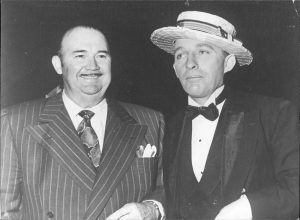 Bing quit college to form a band with three other individuals from his high school, and they called themselves The Musicaladers (with Crosby on “skins”). The musical aggregation broke up after two years, and Crosby and ex-Musicalader Al Rinker—working at the Clemmer Theatre in Spokane—formed a band known as The Three Harmony Aces, which later became The Clemmer Trio (also known as The Clemmer Entertainers, depending on who was in the group at the time). Bing and Al (the brother of singer Mildred Bailey) then decided to try their luck in California, and (through Mildred’s contacts) became members of The Syncopation Revue. Their experience with that group landed them work with the Will Morrissey Hall Revue, and then they got the break of a lifetime when they were hired by bandleader Paul Whiteman to perform in-between his numbers. Crosby and Rinker, with the hiring of a third musician, Harry Barris, became The Rhythm Boys—and the trio worked for Whiteman until 1929, when they then joined Gus Arnheim’s orchestra. Gradually, Bing broke away from the Boys (though Barris would later write some of Der Bingle’s biggest hits, like I Surrender Dear and Wrap Your Troubles in Dreams) to go solo, spurred on by a recording contract with Columbia Records and an offer to make comedy shorts for filmdom’s Mack Sennett.
Bing quit college to form a band with three other individuals from his high school, and they called themselves The Musicaladers (with Crosby on “skins”). The musical aggregation broke up after two years, and Crosby and ex-Musicalader Al Rinker—working at the Clemmer Theatre in Spokane—formed a band known as The Three Harmony Aces, which later became The Clemmer Trio (also known as The Clemmer Entertainers, depending on who was in the group at the time). Bing and Al (the brother of singer Mildred Bailey) then decided to try their luck in California, and (through Mildred’s contacts) became members of The Syncopation Revue. Their experience with that group landed them work with the Will Morrissey Hall Revue, and then they got the break of a lifetime when they were hired by bandleader Paul Whiteman to perform in-between his numbers. Crosby and Rinker, with the hiring of a third musician, Harry Barris, became The Rhythm Boys—and the trio worked for Whiteman until 1929, when they then joined Gus Arnheim’s orchestra. Gradually, Bing broke away from the Boys (though Barris would later write some of Der Bingle’s biggest hits, like I Surrender Dear and Wrap Your Troubles in Dreams) to go solo, spurred on by a recording contract with Columbia Records and an offer to make comedy shorts for filmdom’s Mack Sennett.
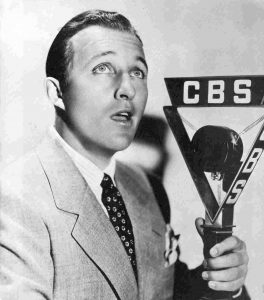 September 2, 1931 marked the debut of Bing Crosby on radio, on a weekly quarter-hour for Cremo cigars over CBS. His work in the Sennett-produced shorts (Sing, Bing, Sing, Blue of the Night) soon convinced Paramount to move him into feature films (though Crosby had previously appeared in such movies as King of Jazz [1930] and Reaching for the Moon [1931]) and throughout the 1930s the popular crooner acted in such vehicles as College Humor (1933), We’re Not Dressing (1934), She Loves Me Not (1934), Mississippi (1935), and Rhythm on the Range (1936). His CBS radio show expanded to a half-hour in the fall of 1933 (sponsored by Woodbury Soap), and in December of 1935 the singer took over for Al Jolson on NBC’s Kraft Music Hall. Music Hall would be the home of Crosby’s crooning and comedy for nearly a decade; audiences loved Bing’s laid-back approach to music/radio and how the program, in the words of writer Carroll Carroll, “treated baseball as if it were opera and opera as if it were baseball.”
September 2, 1931 marked the debut of Bing Crosby on radio, on a weekly quarter-hour for Cremo cigars over CBS. His work in the Sennett-produced shorts (Sing, Bing, Sing, Blue of the Night) soon convinced Paramount to move him into feature films (though Crosby had previously appeared in such movies as King of Jazz [1930] and Reaching for the Moon [1931]) and throughout the 1930s the popular crooner acted in such vehicles as College Humor (1933), We’re Not Dressing (1934), She Loves Me Not (1934), Mississippi (1935), and Rhythm on the Range (1936). His CBS radio show expanded to a half-hour in the fall of 1933 (sponsored by Woodbury Soap), and in December of 1935 the singer took over for Al Jolson on NBC’s Kraft Music Hall. Music Hall would be the home of Crosby’s crooning and comedy for nearly a decade; audiences loved Bing’s laid-back approach to music/radio and how the program, in the words of writer Carroll Carroll, “treated baseball as if it were opera and opera as if it were baseball.”
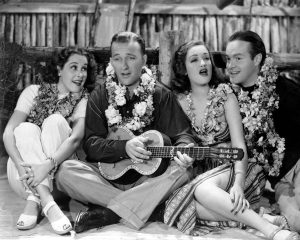 On the Kraft Music Hall, Crosby featured performers who became big names like Bob Burns (who would later get his own solo series in 1941), Mary Martin (an already established Broadway performer who took a leave of absence in 1942 to be on the show), Victor Borge, Connee Boswell, Jerry Lester, George Murphy, and Peggy Lee. John Scott Trotter got established on Music Hall as Bing’s conductor, and two members from Trotter’s band (Jerry Colonna and Spike Jones) also hit it big. When Ken Carpenter was brought aboard, he became Crosby’s longtime announcer. While working to promote Kraft products, Crosby enjoyed incredible success on the pop music charts and in the movies, with hits like Rhythm on the River (1940), Birth of the Blues (1941), and Dixie (1943). It was around this time that Bing Crosby started his fruitful association with comedian Bob Hope in the entertaining “Road” series that began with Road to Singapore (1940) and continued with six successful follow-ups. Crosby and Hope engaged in a mock “feud” similar to Jack Benny and Fred Allen’s, and when one performer appeared on the other’s program—comedic chaos wasn’t far behind.
On the Kraft Music Hall, Crosby featured performers who became big names like Bob Burns (who would later get his own solo series in 1941), Mary Martin (an already established Broadway performer who took a leave of absence in 1942 to be on the show), Victor Borge, Connee Boswell, Jerry Lester, George Murphy, and Peggy Lee. John Scott Trotter got established on Music Hall as Bing’s conductor, and two members from Trotter’s band (Jerry Colonna and Spike Jones) also hit it big. When Ken Carpenter was brought aboard, he became Crosby’s longtime announcer. While working to promote Kraft products, Crosby enjoyed incredible success on the pop music charts and in the movies, with hits like Rhythm on the River (1940), Birth of the Blues (1941), and Dixie (1943). It was around this time that Bing Crosby started his fruitful association with comedian Bob Hope in the entertaining “Road” series that began with Road to Singapore (1940) and continued with six successful follow-ups. Crosby and Hope engaged in a mock “feud” similar to Jack Benny and Fred Allen’s, and when one performer appeared on the other’s program—comedic chaos wasn’t far behind.
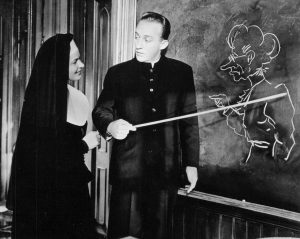 It was his role as “Father Chuck O’Malley” in the comedy-drama Going My Way (1944) that garnered Bing Crosby his solo Oscar trophy and the approval of his peers. Bing reprised the O’Malley role in a follow-up film, The Bells of St. Mary’s (1945), which netted him a second Academy Award nomination and the actor-singer received his third and final Oscar nod for portraying an alcoholic has-been actor in 1954’s The Country Girl. While his film career was going great guns, things were not particularly rosy in the ol’ Music Hall; strained relations between Bing, the sponsor, and NBC led the crooner to jump ship to fledgling ABC and a series entitled Philco Radio Time. The big beef between Bing and the boys (dig that Crosby-like alliteration!) was that Crosby had wanted to take advantage of the strides made in recording to start transcribing his programs in lieu of live broadcasts, allowing him to take advantage of when he was in great voice and stockpiling shows so that he could devote time to his passions of golf and horse racing. (The fact that Bing had invested heavily in Ampex, the firm that developed magnetic recording tape, might have had something to do with Crosby’s decision, too.)
It was his role as “Father Chuck O’Malley” in the comedy-drama Going My Way (1944) that garnered Bing Crosby his solo Oscar trophy and the approval of his peers. Bing reprised the O’Malley role in a follow-up film, The Bells of St. Mary’s (1945), which netted him a second Academy Award nomination and the actor-singer received his third and final Oscar nod for portraying an alcoholic has-been actor in 1954’s The Country Girl. While his film career was going great guns, things were not particularly rosy in the ol’ Music Hall; strained relations between Bing, the sponsor, and NBC led the crooner to jump ship to fledgling ABC and a series entitled Philco Radio Time. The big beef between Bing and the boys (dig that Crosby-like alliteration!) was that Crosby had wanted to take advantage of the strides made in recording to start transcribing his programs in lieu of live broadcasts, allowing him to take advantage of when he was in great voice and stockpiling shows so that he could devote time to his passions of golf and horse racing. (The fact that Bing had invested heavily in Ampex, the firm that developed magnetic recording tape, might have had something to do with Crosby’s decision, too.)
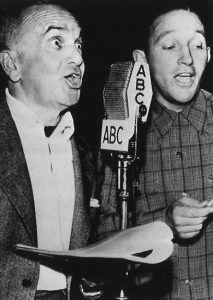 Philco Radio Time provided ABC Radio with a much-needed hit (and Crosby’s victory in the transcription war later inspired radio performers like Hope and Jack Benny to follow suit), but in 1949 Bing was back on CBS (those darn talent raids!) with The Bing Crosby Show—where he stayed until 1954 broadcasting for Chesterfield and General Electric. (Bing’s last radio effort was a five-day-a-week quarter hour heard over CBS from November of 1954 to December of 1956.) The singer’s movies remained popular: Here Comes the Groom (1951), Just For You (1952), White Christmas (1954—a remake of Holiday Inn), High Society (1956), and Say One for Me (1959) are just a few of the more familiar titles. Like his “feuding” partner Bob Hope, Crosby nixed the idea of doing a weekly TV series in lieu of highly-rated boob tube specials and guest appearances on the programs of those people who did decide to tackle the small screen grind.
Philco Radio Time provided ABC Radio with a much-needed hit (and Crosby’s victory in the transcription war later inspired radio performers like Hope and Jack Benny to follow suit), but in 1949 Bing was back on CBS (those darn talent raids!) with The Bing Crosby Show—where he stayed until 1954 broadcasting for Chesterfield and General Electric. (Bing’s last radio effort was a five-day-a-week quarter hour heard over CBS from November of 1954 to December of 1956.) The singer’s movies remained popular: Here Comes the Groom (1951), Just For You (1952), White Christmas (1954—a remake of Holiday Inn), High Society (1956), and Say One for Me (1959) are just a few of the more familiar titles. Like his “feuding” partner Bob Hope, Crosby nixed the idea of doing a weekly TV series in lieu of highly-rated boob tube specials and guest appearances on the programs of those people who did decide to tackle the small screen grind.
 By the 1960s, despite appearances in films like Robin and the 7 Hoods (1964) and Stagecoach (1966), Bing Crosby realized that his time in motion pictures was just about up—he remarked when he and Bob Hope were completing their final “Road” trip, The Road to Hong Kong (1962): “Filming is kind of difficult for someone at my time of life. I’m too old to get the girl and not old enough to be her granddad.” Instead, the popular crooner decided to try his hand with a TV sitcom in the fall of 1964 entitled The Bing Crosby Show, in which he played a retired singer who had taken up teaching electrical engineering at a community college. The show only lasted a season; Crosby had better luck behind the camera with his own Bing Crosby Productions which produced such TV hits as Ben Casey and Hogan’s Heroes.
By the 1960s, despite appearances in films like Robin and the 7 Hoods (1964) and Stagecoach (1966), Bing Crosby realized that his time in motion pictures was just about up—he remarked when he and Bob Hope were completing their final “Road” trip, The Road to Hong Kong (1962): “Filming is kind of difficult for someone at my time of life. I’m too old to get the girl and not old enough to be her granddad.” Instead, the popular crooner decided to try his hand with a TV sitcom in the fall of 1964 entitled The Bing Crosby Show, in which he played a retired singer who had taken up teaching electrical engineering at a community college. The show only lasted a season; Crosby had better luck behind the camera with his own Bing Crosby Productions which produced such TV hits as Ben Casey and Hogan’s Heroes.
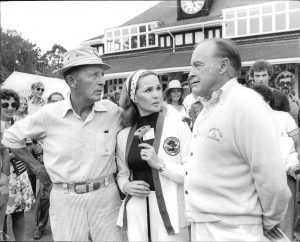 Bing Crosby’s last feature film appearance was a brief bit in the 1974 all-star MGM extravaganza That’s Entertainment! He continued to do TV specials at that time, with a December 1977 outing, Bing Crosby’s Merrie Olde Christmas, acting as his small screen swan song (this is the one where he duets with David Bowie on Peace On Earth/The Little Drummer Boy). 1977 marked the year of his death at the age of 74; he was playing a round of golf on a course in Madrid and after the game collapsed from a massive heart attack twenty yards from the clubhouse. It would be no small exaggeration to note that we lost one of the major entertainers in show business on that day.
Bing Crosby’s last feature film appearance was a brief bit in the 1974 all-star MGM extravaganza That’s Entertainment! He continued to do TV specials at that time, with a December 1977 outing, Bing Crosby’s Merrie Olde Christmas, acting as his small screen swan song (this is the one where he duets with David Bowie on Peace On Earth/The Little Drummer Boy). 1977 marked the year of his death at the age of 74; he was playing a round of golf on a course in Madrid and after the game collapsed from a massive heart attack twenty yards from the clubhouse. It would be no small exaggeration to note that we lost one of the major entertainers in show business on that day.
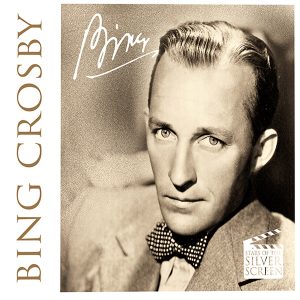 Radio Spirits features our birthday boy’s Philco Radio Time series as one of several broadcasts in our potpourri collection Comedy Goes West (a January 7, 1948 show with guests Walter O’Keefe and Brace Beemer [a.k.a. The Lone Ranger!]), and you can also listen to Der Bingle on Jack Benny & Friends (a classic February 15, 1953 show highlighting “The Life of Bing Crosby”). For the pop music side of The Old Groaner, check out the CD sets George Gershwin Collection (They All Laughed and Mine [with Judy Garland]), You Make Me Feel So Young (How Deep is the Ocean, Moonlight Becomes You, Too Marvelous for Words, You’re Getting to Be a Habit with Me), Great American Songbook: The Crooners (Just One More Chance, Out of Nowhere, Day by Day [with Mel Torme]), With a Song in My Heart: Hooray for Hollywood (Blue Skies, Swinging on a Star, The Road to Morocco [with Bob Hope]), and Swing Something Simple (When You and I Were Young, Maggie, Deep in the Heart of Texas, and two duets with his son Gary—Play a Simple Melody and Down by the Riverside). The singer we often associate with the holidays sings his classic White Christmas on the CD collections The Very Best of Christmas, Christmas Crooners, and Wonderful Christmas: 75 Essential Christmas Classics…and performs other Yuletide favorites on 15 Christmas Favorites, We Wish You a Merry Christmas, and Do You Hear What I Hear? (my favorite Crosby Christmas carol). In addition, Bing can be spotted in our DVD collections Bob Hope: Entertaining the Troops, Stars in Their Shorts, and Best of Andy Williams. As the ice cream on the birthday cake, we invite you to drink deeply of Bing Crosby—a massive 3-CD set with Crosby solos and hit duets featuring the likes of Louis Armstrong, the Andrews Sisters and so many more!
Radio Spirits features our birthday boy’s Philco Radio Time series as one of several broadcasts in our potpourri collection Comedy Goes West (a January 7, 1948 show with guests Walter O’Keefe and Brace Beemer [a.k.a. The Lone Ranger!]), and you can also listen to Der Bingle on Jack Benny & Friends (a classic February 15, 1953 show highlighting “The Life of Bing Crosby”). For the pop music side of The Old Groaner, check out the CD sets George Gershwin Collection (They All Laughed and Mine [with Judy Garland]), You Make Me Feel So Young (How Deep is the Ocean, Moonlight Becomes You, Too Marvelous for Words, You’re Getting to Be a Habit with Me), Great American Songbook: The Crooners (Just One More Chance, Out of Nowhere, Day by Day [with Mel Torme]), With a Song in My Heart: Hooray for Hollywood (Blue Skies, Swinging on a Star, The Road to Morocco [with Bob Hope]), and Swing Something Simple (When You and I Were Young, Maggie, Deep in the Heart of Texas, and two duets with his son Gary—Play a Simple Melody and Down by the Riverside). The singer we often associate with the holidays sings his classic White Christmas on the CD collections The Very Best of Christmas, Christmas Crooners, and Wonderful Christmas: 75 Essential Christmas Classics…and performs other Yuletide favorites on 15 Christmas Favorites, We Wish You a Merry Christmas, and Do You Hear What I Hear? (my favorite Crosby Christmas carol). In addition, Bing can be spotted in our DVD collections Bob Hope: Entertaining the Troops, Stars in Their Shorts, and Best of Andy Williams. As the ice cream on the birthday cake, we invite you to drink deeply of Bing Crosby—a massive 3-CD set with Crosby solos and hit duets featuring the likes of Louis Armstrong, the Andrews Sisters and so many more!

